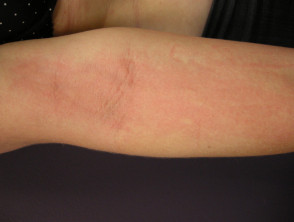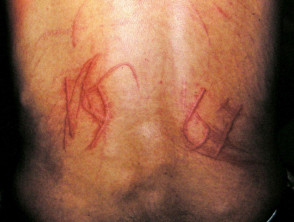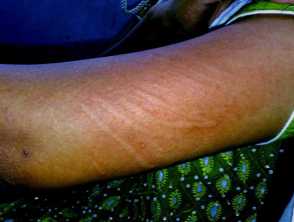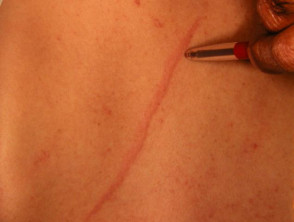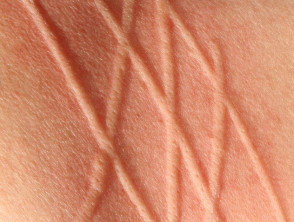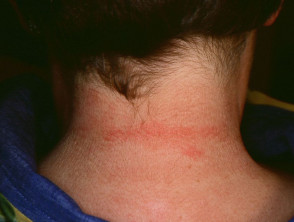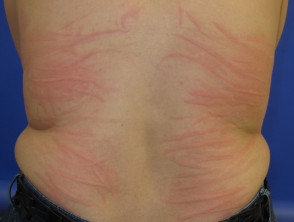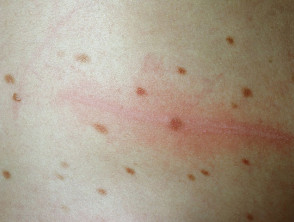What is dermographism?
Dermographism is an exaggerated weal and flare response that occurs within minutes of the skin being stroked or scratched. Dermographism is the most common form of physical or chronic inducible urticaria. It is also called dermatographia and dermographic urticaria.
Dermographism
Who gets dermographism?
Dermographism can appear at any age, including children, but onset is most common in young adults. There does not appear to be any racial predilection or differences between the sexes. Some studies have reported a positive family history (OMIM 125635).
In 25–50% of people, firm stroking of the skin first produces a red flare, then slight swelling along the line of the stroke. In 5% of the population, this response is exaggerated enough to be called dermographism. Only in a minority of cases does it cause symptoms.
Most people with dermographism are otherwise healthy. Dermographism can be seen in association with scabies and some medications.
The incidence of true dermographism does not appear to be increased in association with atopy, although this is still debated in the literature.
What causes dermographism?
The exact mechanism of dermographism is not known. Skin trauma may release an (as yet unidentified) antigen that reacts with the membrane-bound IgE on mast cells triggering release of histamine and other inflammatory mediators. Histamine causes local vasodilation and leaking of fluid from small blood vessels which leads to fluid accumulation in the skin. Support for this theory is that dermographism can be passively transferred to others.
What are the clinical features of dermographism?
Immediate dermographism
Immediate dermographism presents with linear weals and a surrounding red flare which appears 1–3 minutes after stroking and resolves in 30–60 minutes. It can be classified as:
- Simple dermographism (skin writing)
- Asymptomatic
- Very common
- Probably an exaggerated physiological response to moderate/firm or repeated stroking or rubbing
- Symptomatic dermographism (factitious urticaria)
- Associated itch
- Worse in the evening or at night
- Follows gentle stroking or light pressure from clothing
- Can have a significant impact on quality of life, particularly due to sleep disturbance and fatigue.
Although dermographism is typically described involving the skin, it can also affect mucous membranes such as the oral mucosa/lips and vulva.
Other forms of true dermographism
- Red dermographism
- Response to rubbing rather than scratching
- Reported in 3% of the general population with a middle-aged female predominance
- Delayed dermographism
- By definition, dermographism appearing at least 30 minutes after stroking. It may be described after a typical weal of immediate dermographism comes and goes, 3–6 hours later a wide weal reappears without a flare at the same site and persists for up to 48 hours
- Associated with burning and tenderness of the weal
- Cholinergic dermographism (beaded dermographism)
- Related to an increased core temperature often in association with cholinergic urticaria
- Linear broad erythematous flare and 1–2mm weals following stroking.
Non-urticarial forms of dermographism
- White dermographism
- White line (without a weal) following the scratch can be seen in atopic dermatitis or other forms of dermatitis.
- Black dermographism
- Black or green line (without a weal) related to pressure and staining from a metal object.
How is dermographism diagnosed?
Dermographism is a clinical diagnosis elicited using a sufficiently firm stroke of the skin usually across the back and waiting several minutes for the reaction to develop. A dermographometer is a device that applies a range of pressures, for example the Fric test, uses a plastic device with pegs of varying lengths which apply varying pressures. Antihistamines taken in the preceding days can cause a negative result.
Eliciting dermographism
A skin biopsy is rarely required except occasionally to distinguish dermographism from mastocytosis. Histology of dermographism is nonspecific with oedema of the dermis with perivascular mononuclear cells.
What is the differential diagnosis for dermographism?
- Urticaria: particularly delayed pressure urticaria and contact urticaria
- Latex glove allergy
- Mastocytosis: Darier sign of urticaria pigmentosa and other cutaneous mastocytoses.
Differential diagnosis of dermographism
What is the treatment for dermographism?
General measures
- Loose fitting clothing
- Avoid triggers, such as very hot water or vigorous towel rubbing
- Treat associated causes if identified, such as scabies
- Psychological counselling, anxiolytics, antidepressants.
Specific treatments
- Second generation, non-sedating H1-antihistamines such as cetirizine or loratadine, which may be required in high dose and long-term
- Phototherapy
- Omalizumab.
Delayed dermographism appears to be treatment-resistant.
What is the outcome for dermographism?
Dermographism can last for months or years, with idiopathic symptomatic dermographism typically persisting on average for 6 years. Red dermographism can improve within 6 months. Dermographism associated with a recognised trigger such as scabies lasts only days to weeks. Spontaneous resolution is common.
